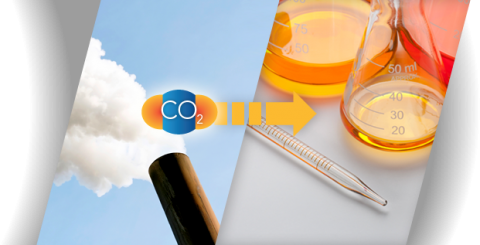Production chemicals from carbon
Liquid LightLiquid Light’s electrocatalytic ‘reaction cell’ is a key part of the company’s new process to produce major chemicals, like ethylene glycol, from widely available, inexpensive carbon dioxide. Production plants would combine numerous cells, as done today for other mainstream chemicals.
Liquid Light’s advances that enable commercialization include the development of long-lasting catalyst components; the ability to run continuously for extended times; and major progress in energy efficiency.
Promising economics from low-cost feedstock and proven-efficient process
Results to date highlight promising economics in three key dimensions:
Process performance validated at lab scale: In test runs, Liquid Light has met the targets needed for cost-advantaged production in metrics including energy needed per unit of output; rate of production; yield; and stability/longevity of cell components.
Large savings in feedstock costs: Liquid Light’s process requires $125 or less of CO2 to make a ton of MEG. Other processes require an estimated $617 to $1,113 of feedstocks derived from oil, natural gas or corn. These differences are especially significant as MEG sells for $700 to $1,400 per metric ton.
High project value for technology licensees: Current estimates show that a 400kT per year Liquid Light MEG plant would offer more than $250 million in added project value as compared to a plant built using the best currently available process technology. A 625kTa plant would have a 15 year net present value of over $850 million to a licensee.
Liquid Light’s process: Reduction in carbon footprint for chemical production
Liquid Light’s process also reduces the overall carbon footprint for chemical production compared to conventional methods, when powered with electricity produced from natural gas, nuclear, advanced coal and renewable sources. Further, Liquid Light’s process can sequester carbon – meaning it is a net reducer of carbon in the environment – when using energy sources like solar, hydro, wind or nuclear power. To further demonstrate this potential benefit, the company also showed the process can be powered by intermittently-available renewable energy sources like solar and wind. The result is that chemicals can be made directly from renewable energy sources and CO2.
“We’re delighted to be introducing a new and valuable alternative for the mainstream chemical industry,” said Kyle Teamey, CEO of Liquid Light. “Liquid Light’s technology offers a new and cost-effective way to make everyday products from plain old carbon dioxide. This is a great way to reduce our dependence on fossil fuels while we simultaneously consume an environmental pollutant.”

